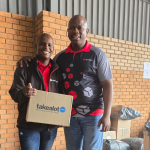The fight for better female representation in science and technology has been long and difficult. But there are, at last, signs that the gap is beginning to close.
According to a 2021 study by Deloitte, female representation at global technology firms will, on average, reach 33% in 2022. And while the number of women in technical roles continues to lag that number, it’s also improved markedly over the past few years. Today, 25% of technical roles go to women, compared with just over 22% in 2019.
If we are to build on those successes, we don’t just need to keep applying societal pressure, we also need to foster inter-generational support networks between women at various stages of development in their STEM careers.
Every year, the United Nations marks The International Day of Women and Girls in Science on 11 February. This year, the theme is “Equity, Diversity, and Inclusion: Water Unites Us”. The theme’s primary aim is to highlight the role science and technology can play in improving water and sanitation around the globe. It should also, however, be a reminder for women to come together and tackle the challenges they face like water. When water flows around obstacles, it also gradually erodes them, making the flow easier in the future.
This secondary goal could also help when it comes to achieving the primary one. And that’s critical. According to the UN, billions of people around the world will be unable to access safely managed household drinking water, sanitation, and hygiene services in 2030 unless access progress rates quadruple. These challenges are exacerbated by rising demand, poor management, and failure to conserve water resources, and compounded by climate change.
Women innovators, with a solid background in science and technology, will be key to finding innovative solutions to these problems. In fact, they already are. Whether it’s using solar power to create fresh drinking water from air or using ICT technologies for pollution monitoring and management, women are playing a pivotal role in water security innovation.
At Huawei, we are acutely aware of the need for transformation and have factored it in to our various graduate and student empowerment programmes which target 50% female students. Basani Mathebula, a Junior Network Engineer at Huawei, shows how beneficial such an approach can be. As a part of Huawei South Africa’s senior executive, I’ve taken a personal interest in her career and those of other young women in the business, mentoring them as they progress professionally. This personal network builds on other Huawei initiatives.
Prior to joining Huawei, Mathebula was part of our “Seeds for the Future” programme. Since 2016, 90 students have gone through the programme, which exposes participants to technologies that will be crucial as they enter the workplace.
Mathebula’s path into the ICT space hasn’t always been simple. Fewer than 30% of the girls in her school studied Mathematics and Science up to matric level and in grade 11 she got just 24% for Mathematics. Through grit, determination, and a lot of extra lessons, she ended up with five distinctions and was the top achiever in her school.
She’s also well attuned to the discrimination women face in the ICT space.
“Women are more prone to stereotyping because society still labels ICT related careers as being labeled for men,” she says. “This helps reinforce the male domination of the sector and is a contributing factor in discouraging women from pursuing a career in ICT.”
In order for that to change, she points out that young girls and women must be empowered to pursue ICT related skills such as artificial intelligence (AI), big data, networks, cyber security, IoT, and software engineering.
She also believes that these technologies can help meet the UN goal of achieving universal access to clean drinking water.
“Women and girls can form innovative projects that utilise ICT tools to accelerate the rollout of
clean water and sanitation,” she says. “Working together, women can not only improve access to sanitation, they can also brainstorm ways to modernise existing water and sanitation infrastructure to enable efficient solutions that save on cost.”
But simply getting more girls and women into the ICT space isn’t enough. It’s also important to keep them in space once they’re in it. Research shows that almost half of women working in technology drop out, compared with 20% in other industries.
Inter-generational support and mentorship networks could be crucial when it comes to improving those numbers. With the support of other women who have made it to a high level in the ICT space, up-and-coming ICT workers are more likely to thrive as they advance in their careers. Mentorship doesn’t just benefit the people receiving it either. Research has shown, for example, that people who take on mentorship roles are significantly more likely to be promoted than those who don’t.
We’ve already broken down a lot of the barriers that held women and girls back in science and technology. Working together, we can break down a lot more. The UN’s 2030 Sustainable Development Goal – ‘leaving no one behind’ – calls for transformative shifts, integrated approaches, and innovative solutions to overcome the structural barriers to sustainable development. Innovation and technology provide unpreceded opportunities to reach those who are the most likely to be left behind. DM
About Huawei
Huawei is a leading global provider of information and communications technology (ICT) infrastructure and smart devices. With integrated solutions across four key domains – telecom networks, IT, smart devices, and cloud services – we are committed to bringing digital to every person, home and organization for a fully connected, intelligent world.
Huawei’s end-to-end portfolio of products, solutions and services are both competitive and secure. Through open collaboration with ecosystem partners, we create lasting value for our customers, working to empower people, enrich home life, and inspire innovation in organizations of all shapes and sizes.
At Huawei, innovation focuses on customer needs. We invest heavily in basic research, concentrating on technological breakthroughs that drive the world forward. We have more than 180,000 employees, and we operate in more than 170 countries and regions. Founded in 1987, Huawei is a private company fully owned by its employees.


















 Become an Insider
Become an Insider
Comments - Please login in order to comment.